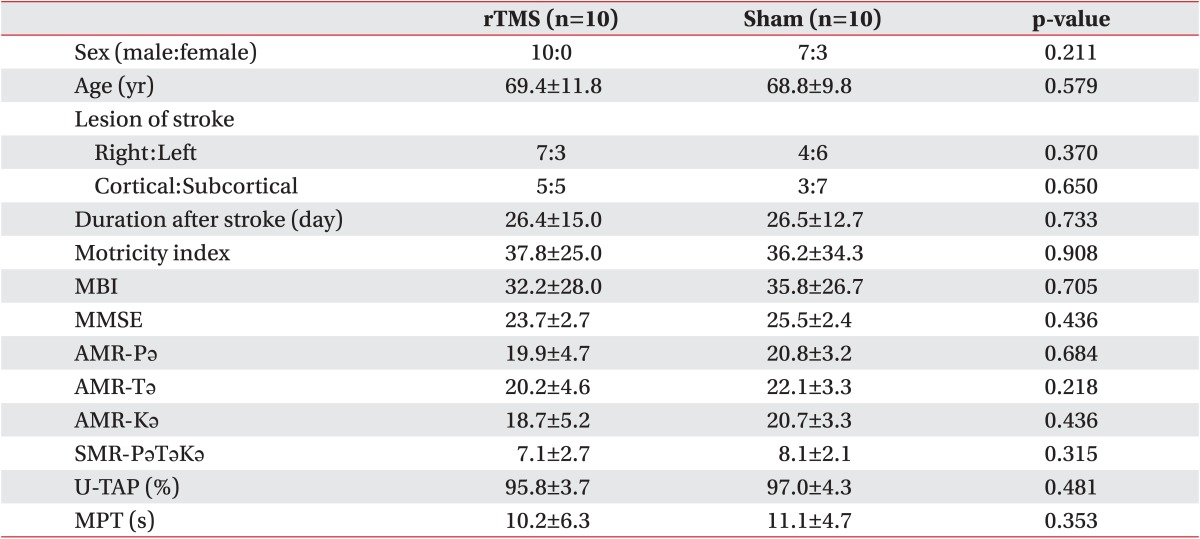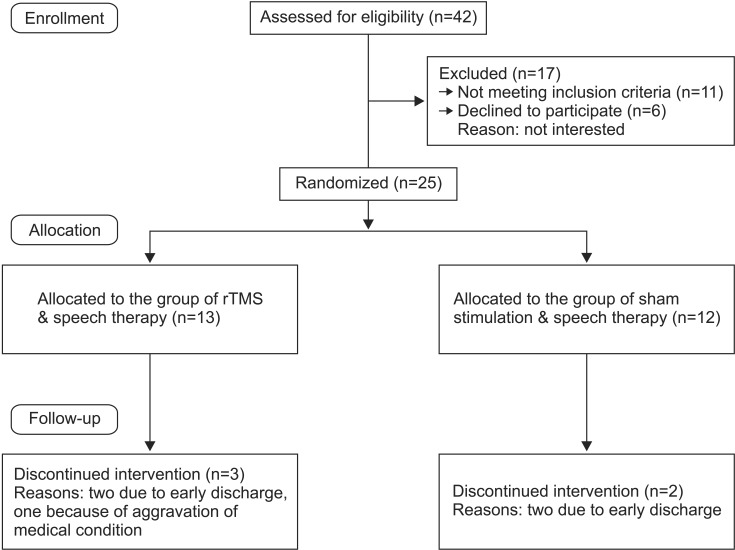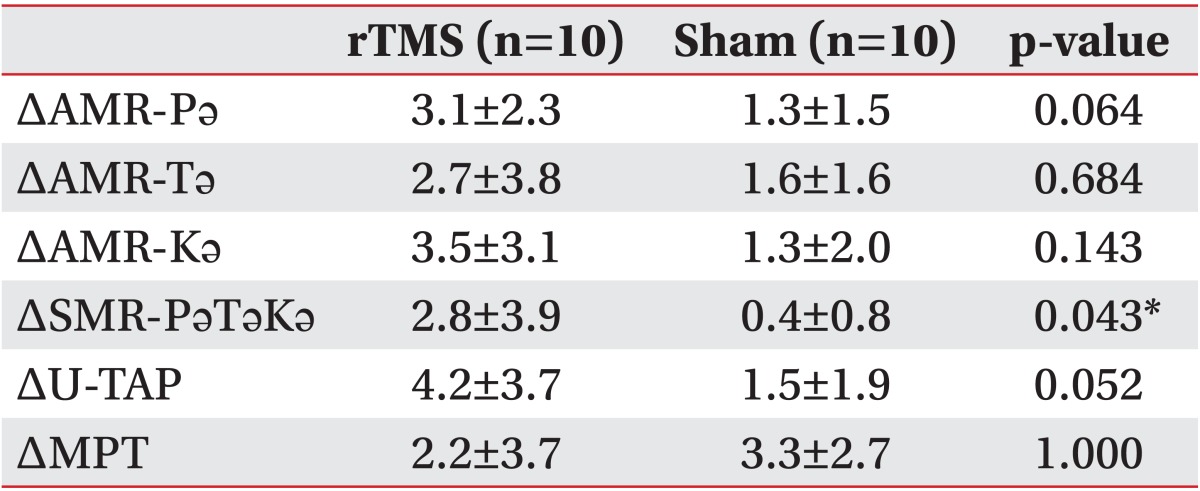1. Yorkston KM, Beukelman DR. Ataxic dysarthria: treatment sequences based on intelligibility and prosodic considerations. J Speech Hear Disord. 1981; 46:398–404. PMID:
7300267.
2. Martin BJ, Corlew MM. The incidence of communication disorders in dysphagic patients. J Speech Hear Disord. 1990; 55:28–32. PMID:
2299837.

3. Flowers HL, Silver FL, Fang J, Rochon E, Martino R. The incidence, co-occurrence, and predictors of dysphagia, dysarthria, and aphasia after first-ever acute ischemic stroke. J Commun Disord. 2013; 46:238–248. PMID:
23642855.

4. Brady MC, Clark AM, Dickson S, Paton G, Barbour RS. The impact of stroke-related dysarthria on social participation and implications for rehabilitation. Disabil Rehabil. 2011; 33:178–186. PMID:
20831375.

5. Sellars C, Hughes T, Langhorne P. Speech and language therapy for dysarthria due to non-progressive brain damage (review). Chichester:: John Wiley & Sons;2009.
6. Alonso-Alonso M, Fregni F, Pascual-Leone A. Brain stimulation in poststroke rehabilitation. Cerebrovasc Dis. 2007; 24(Suppl 1):157–166. PMID:
17971652.

7. Lefaucheur JP. Stroke recovery can be enhanced by using repetitive transcranial magnetic stimulation (rTMS). Neurophysiol Clin. 2006; 36:105–115. PMID:
17046605.
8. Pascual-Leone A, Amedi A, Fregni F, Merabet LB. The plastic human brain cortex. Annu Rev Neurosci. 2005; 28:377–401. PMID:
16022601.

9. Peinemann A, Reimer B, Loer C, Quartarone A, Munchau A, Conrad B, et al. Long-lasting increase in corticospinal excitability after 1800 pulses of subthreshold 5 Hz repetitive TMS to the primary motor cortex. Clin Neurophysiol. 2004; 115:1519–1526. PMID:
15203053.

10. Maeda F, Keenan JP, Tormos JM, Topka H, Pascual-Leone A. Modulation of corticospinal excitability by repetitive transcranial magnetic stimulation. Clin Neurophysiol. 2000; 111:800–805. PMID:
10802449.

11. Muellbacher W, Ziemann U, Boroojerdi B, Hallett M. Effects of low-frequency transcranial magnetic stimulation on motor excitability and basic motor behavior. Clin Neurophysiol. 2000; 111:1002–1007. PMID:
10825706.

12. Hsu WY, Cheng CH, Liao KK, Lee IH, Lin YY. Effects of repetitive transcranial magnetic stimulation on motor functions in patients with stroke: a meta-analysis. Stroke. 2012; 43:1849–1857. PMID:
22713491.
13. You DS, Chun MH, Kim DY, Han EY, Jung SE. The effects of transcranial direct current stimulation on dysarthria in stroke patients. J Korean Acad Rehabil Med. 2010; 34:10–14.
14. Takeuchi N, Chuma T, Matsuo Y, Watanabe I, Ikoma K. Repetitive transcranial magnetic stimulation of contralesional primary motor cortex improves hand function after stroke. Stroke. 2005; 36:2681–2686. PMID:
16254224.

15. Kim YH, You SH, Ko MH, Park JW, Lee KH, Jang SH, et al. Repetitive transcranial magnetic stimulationinduced corticomotor excitability and associated motor skill acquisition in chronic stroke. Stroke. 2006; 37:1471–1476. PMID:
16675743.

16. Khedr EM, Etraby AE, Hemeda M, Nasef AM, Razek AA. Long-term effect of repetitive transcranial magnetic stimulation on motor function recovery after acute ischemic stroke. Acta Neurol Scand. 2010; 121:30–37. PMID:
19678808.

17. Talelli P, Greenwood RJ, Rothwell JC. Exploring Theta Burst Stimulation as an intervention to improve motor recovery in chronic stroke. Clin Neurophysiol. 2007; 118:333–342. PMID:
17166765.

18. Fimbel EJ, Domingo PP, Lamoureux D, Beuter A. Automatic detection of movement disorders using recordings of rapid alternating movements. J Neurosci Methods. 2005; 146:183–190. PMID:
16054508.

19. Kent RD, Weismer G, Kent JF, Vorperian HK, Duffy JR. Acoustic studies of dysarthric speech: methods, progress, and potential. J Commun Disord. 1999; 32:141–180. 183–186. PMID:
10382143.
20. Tjaden K, Watling E. Characteristics of diadochokinesis in multiple sclerosis and Parkinson's disease. Folia Phoniatr Logop. 2003; 55:241–259. PMID:
12931058.

21. Urban PP, Rolke R, Wicht S, Keilmann A, Stoeter P, Hopf HC, et al. Left-hemispheric dominance for articulation: a prospective study on acute ischaemic dysarthria at different localizations. Brain. 2006; 129(Pt 3):767–777. PMID:
16418180.

22. Seikel JA, King DW, Drumright DG. Anatomy & physiology for speech, language, and hearing. 2nd ed. San Diego: Singular Publishing;2000.
23. Borden GJ, Harris KS, Raphael LJ. Speech science primer: physiology, acoustics, and perception of speech. 3rd ed. Baltimore: Lippincott Williams & Wilkins;1994.
24. Liegeois FJ, Morgan AT. Neural bases of childhood speech disorders: lateralization and plasticity for speech functions during development. Neurosci Biobehav Rev. 2012; 36:439–458. PMID:
21827785.
25. Urban PP, Hopf HC, Fleischer S, Zorowka PG, Muller-Forell W. Impaired cortico-bulbar tract function in dysarthria due to hemispheric stroke: functional testing using transcranial magnetic stimulation. Brain. 1997; 120(Pt 6):1077–1084. PMID:
9217690.






 PDF
PDF ePub
ePub Citation
Citation Print
Print





 XML Download
XML Download